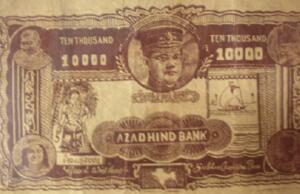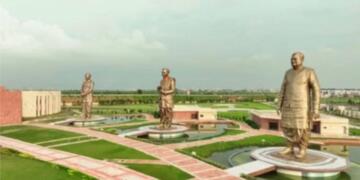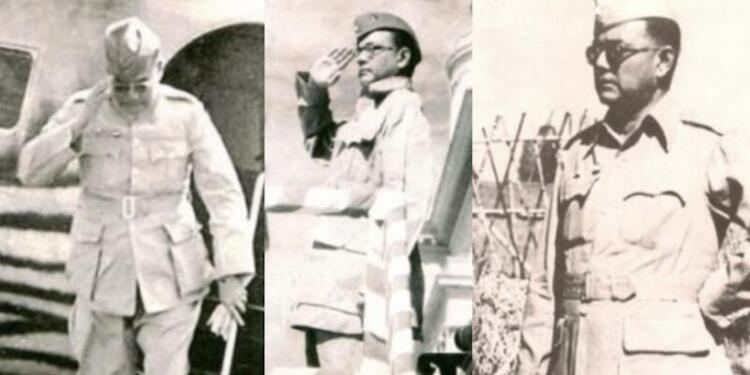“My heroes! Your war cry should be- ‘Delhi Chalo! Delhi Chalo!’ I don’t know how many of us will survive in this battle for freedom, but I know that in the end we will win and until our remaining warriors hoist the flag of victory on the Red Fort, our objective will not be accomplished.”
On 5 July 1943, these words of the supreme commander of the Azad Hind Fauj, Subhash Chandra Bose, were writing the script for India’s revolution and the formation of its new government.
Just a day before this, Rasbihari Bose had handed over the command of the Azad Hind Fauj (INA) to Subhash Chandra Bose at Cathay Bhawan in Singapore.
After this, for the next few months, Netaji continued to work hard and travel continuously to set up an organization to take charge of the freedom movement and finally, on this day (21 October) in 1943, during a historic public meeting in Singapore, he announced the formation of the interim Azad Hind Government. It was also known as Arzi Hukumat-e-Azad Hind and this government was recognized by nine countries including Germany, Japan, Italy, Philippines, Korea, China and Ireland.
This government formed against the most powerful empire of the world at that time was not only on paper but this government also had its own army, bank, newspaper, currency, flag, national anthem, postage stamps and intelligence system. Also, the next day of the formation of the government, Netaji formed a women’s regiment in the Azad Hind Fauj and its command was in the hands of Captain Lakshmi Swaminathan. This regiment was also called Rani Jhansi Regiment.
Shishir Kumar Bose has written in his book ‘Netaji Subhash Chandra Bose’, “After the announcement of the formation of the independent government, Netaji also took the oath of office as the head of the nation and the Prime Minister. That precious moment was so full of emotions that Netaji started sobbing and tears started flowing on his cheeks. For the first time in 200 years, the freedom fighters of India felt their independent nationhood.” ‘I am not the head of India but its representative’
After the formation of this government, in November 1943, Netaji participated in the Assembly of Greater East Asian Nations in Tokyo and in this conference a resolution of ‘full sympathy and support for India’s freedom struggle’ was passed. Historian Professor Kapil Kumar tells that during this conference, when Netaji was addressed as the head of India, he said that I am the representative of India. According to Professor Kumar, “Netaji had said that the people of India will choose the head in the government of independent India to be formed after the departure of the British.” In this conference, the then Prime Minister of Japan Tojo had announced to give the administrative jurisdiction of the Andaman and Nicobar Islands occupied by the Japanese Army to the Azad Hind Government.
Azad Hind Government’s occupation of Andaman-Nicobar
Azad Hind Government had acquired the jurisdiction of the Andaman and Nicobar Islands as its first state. The British had built a Cellular Jail in Port Blair on this island, where freedom fighters were given the punishment of Kalapani. For this, Netaji Bose reached Andaman on 29 December 1943. Shishir Bose has written in the book ‘Netaji Subhash Chandra Bose’, “Netaji, in the capacity of the head of the nation, hoisted the national tricolour in front of a huge crowd at the Gymkhana Ground.” Shishir Bose writes, “During the stay, Netaji and his team stayed in the residence of the British Chief Commissioner on Ross Island and the national tricolour was hoisted proudly on it. Netaji renamed Andaman as ‘Shaheed Islands’ and Nicobar as ‘Swaraj Islands’.”
The headquarters of the government shifted from Singapore to Rangoon
When it was decided that the Azad Hind Fauj would enter India via Burma, Netaji shifted the headquarters of the Azad Hind Government from Singapore to Rangoon, closer to India, on 7 January 1944. Also, the No. 1 guerrilla regiment ‘Subhash Brigade’ commanded by Shahnawaz Khan reached Rangoon after walking 400 miles. In February 1944, on the Arakan front, the Azad Hind Fauj fought on the Chittagong-Janewali road and here the army proved to be better than the enemy army. After this battle, even the Japanese army accepted the strength of the Azad Hind Fauj.
The Battle of Imphal and the Appointment of the Governor of the Azad Hind Government
The Azad Hind Fauj fighting under the leadership of Netaji attacked Imphal in mid-March 1944 and three Japanese divisions camped along with the INA took part in it. Shishir Bose has written in ‘Netaji Subhash Chandra Bose’, “For Netaji and the Azad Hind Fauj, this meant the forced entry of armed revolutionaries into India to create a military camp for the future freedom struggle and to open the way to the Brahmaputra Valley.” On 21 March 1944, Netaji announced in a press conference that the Azad Hind Fauj fighting with the Japanese Army had entered India on 18 March. Shishir Bose writes, “In the first week of April, Netaji appointed his cabinet member A.C. Chatterjee as the nominated governor of the liberated areas. The administrative section of the interim government, ‘Azad Hind Dal’, was ready to take over the governance of the liberated areas moving forward along with the army.”
Story of ‘Azad Hind Bank’
This government of Netaji had also established a bank. This bank was in Rangoon and it was called ‘Azad Hind Bank’. Historian Professor Kapil Kumar tells that the Japanese did not want Netaji to establish his own bank and for this the talks continued for 3 days. Professor Kapil Kumar has told that the Japanese had asked Netaji that where will the money for the bank come from, on this Netaji had said that I have money which my Indians have given. This bank continued to work even after August 1945.

Misconceptions about Rani Jhansi Regiment
Netaji was a man of thinking far ahead of his time and at that time he had established a women’s regiment. Netaji had said that I want such young women who can fight with a sword like the queen of Jhansi. However, many leftist historians and people associated with them have spread misconceptions that this regiment never participated in the war. Professor Kapil Kumar says, “During my research, I found three such accounts which make it clear that Rani Jhansi Regiment faced the English paratroopers. While returning from Rangoon, they faced the British guerrillas and at one place, stopped the English army from advancing for 6 hours.”

Also read: https://tfipost.com/2024/10/how-diwali-and-other-hindu-festive-seasons-spur-economic-growth/
National Anthem of Azad Hind Government
Netaji had got ‘Bharato Bhagyo Bidhata’ written in Bengali by Gurudev Rabindranath Tagore translated into easy Hindustani language. The responsibility of its translation was given to Mumtaz Hussain of Azad Hind Radio and Colonel Abid Hasan Safrani of Azad Hind Fauj and after translation, it became the national anthem of the government.
May the rain of happiness and peace fall, India is awakened
Punjab, Sindh, Gujarat, Maratha, Dravid, Utkal, Bengal
The restless sea, Vindhya, Himalayas, blue Yamuna, Ganga
We sing your praises daily, may we get life from you
All our bodies get hope.
May you shine on the world like the sun, may the name of India be auspicious,
Hail! Hail! Hail! Hail! Hail! Hail!
May your sweet voice fill everyone’s heart with love,
Residents of every province, people of every religion,
Erasing all differences and distinctions,
All come to your lap,
We weave a garland of love.
May you shine on the world like the sun, may the name of India be auspicious,
Hail! Hail! Hail! Hail! Hail! Hail!
On auspicious mornings, the birds sing your praises
The fragrant winds bring joy to life
All call out to India together, shout slogans of Jai Azad Hind.
Our beloved country. Shine like the sun upon the world, may the name of India be auspicious,
Victory! Victory! Victory! Victory! Victory!































